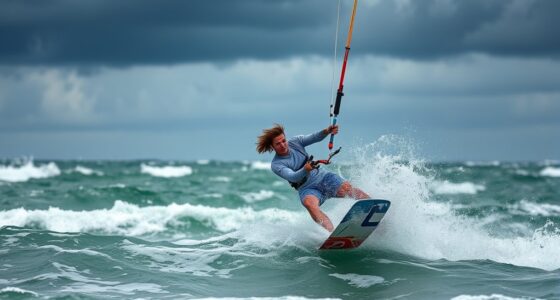Flyboarding competitions and leagues are booming, combining adrenaline with artistry. Your safety should always come first—wear a life jacket and practice regularly to hone your skills. You’ll gain confidence by working with experienced coaches and joining training camps. Plus, the community of flyboarding enthusiasts offers support and camaraderie that enhances your competitive experience. As you embrace the sport’s excitement, you’ll discover new creative opportunities and personal growth. There’s so much more to explore about this thrilling sport.
Key Takeaways
- Flyboarding competitions promote athlete skill development through structured events and challenges, enhancing performance and safety awareness.
- The sport’s community fosters camaraderie and support, encouraging participation and collaboration among athletes.
- Engaging in training camps with experienced coaches accelerates skill acquisition and boosts confidence in competition settings.
- Emphasizing safety precautions, such as wearing life jackets and maintaining awareness, attracts more participants and spectators.
- The combination of adrenaline and artistry in competitions showcases the sport’s unique appeal, attracting new enthusiasts and growing its popularity.

As you step onto the water’s edge, the thrill of flyboarding competitions beckons, offering a unique blend of adrenaline and artistry. You can feel the energy in the air, as experienced and novice athletes alike prepare to showcase their skills. Flyboarding isn’t just about the rush of soaring above the water; it’s a sport that demands rigorous training and a commitment to safety. Before you dive in to the world of competitive flyboarding, understanding the essential safety precautions is *paramount*.
First and foremost, you need to prioritize your safety and that of others. Wearing a life jacket is non-negotiable. This simple piece of equipment can save your life in case of an unexpected fall. Also, *guarantee* your flyboard harness is fitted correctly to prevent any mishaps during your performance. Competitions often take place in designated areas, but you should always be aware of your surroundings and other competitors. Avoid crowded zones and keep a safe distance from other athletes to minimize the risk of collisions.
Next, let’s talk about the importance of athlete training. To thrive in flyboarding competitions, you must commit to both physical fitness and skill development. Regular workouts focusing on core strength, balance, and endurance will prepare your body for the demands of flyboarding. You can’t just jump on the board and expect to excel; practice is *indispensable*. Dedicate time each week to refine your techniques, from simple take-offs to complex aerial tricks. The more you train, the more confident you’ll feel when it’s your turn to compete. Additionally, understanding the concept of color accuracy can help improve your overall performance by ensuring you can see your surroundings clearly while flyboarding.
Additionally, consider working with experienced coaches or joining training camps. They can provide invaluable tips and feedback to elevate your performance. You’ll learn how to execute maneuvers safely and effectively, which is *indispensable* in a competitive environment. Observing seasoned athletes can also inspire you, helping you to visualize your goals and push your limits.
As you immerse yourself in this thrilling sport, remember that flyboarding is about more than just competition; it’s a community. You’ll meet fellow enthusiasts who share your passion and can offer support and camaraderie. The friendships you build will enhance your flyboarding experience, making the journey even more rewarding.
With the right mindset, training, and safety precautions, you can soar to new heights in flyboarding competitions, embracing both the excitement and artistry this sport has to offer.
Frequently Asked Questions
What Equipment Is Needed for Flyboarding Competitions?
For flyboarding competitions, you’ll need a flyboard, a personal watercraft (PWC), and a safety vest. Don’t forget to wear a helmet for added flyboarding safety. You should also have a life jacket and a communication device for emergencies. Before competing, it’s vital to undergo thorough flyboarding training to master techniques and guarantee safety. Proper equipment and training will help you perform your best while minimizing risks during your competition.
How Are Flyboarding Competition Scores Determined?
In flyboarding, competition scores stem from a scoring system that emphasizes elegance and execution. Judges meticulously assess your maneuvers based on specific judging criteria, including difficulty, style, and overall performance. You’ll need to showcase your skills through smooth handovers and impressive tricks. Points accumulate, reflecting your finesse and flair, so endeavor for standout stunts that captivate the crowd and judges alike. Remember, precision and presentation play pivotal roles in your final score!
Are There Age Restrictions for Flyboarding Participants?
Yes, there are age restrictions for flyboarding participants, typically set by event organizers. Most competitions require participants to be at least 16 years old, but some might permit younger athletes with parental consent. These age restrictions are in place to guarantee safety guidelines are followed, as flyboarding can be physically demanding. Always check the specific event rules, as they may vary, ensuring you meet the requirements before participating.
Can Beginners Compete in Flyboarding Events?
Absolutely, beginners can compete in flyboarding events! However, you’ll face beginner challenges that might test your skills. It’s essential to prioritize safety gear, like helmets and life jackets, ensuring you’re protected while you’re perfecting your performance. Many events welcome novice participants, providing a supportive environment to learn and grow. So, gear up, get ready, and plunge into the exhilarating world of flyboarding competitions—your adventure awaits!
Where Can I Find Upcoming Flyboarding Competitions?
You can find upcoming flyboarding competitions by checking local clubs that offer events. Many of these clubs list their competitions on their websites or social media pages. Additionally, keep an eye on event registration platforms where flyboarding events are often posted. Joining community forums or Facebook groups dedicated to flyboarding can also help you stay in the loop about new competitions and registration details. Don’t miss out on the excitement!
Conclusion
As flyboarding competitions rise, they’re not just about water and adrenaline; they’re a modern-day chariot race, where athletes defy gravity and embrace the thrill of the unknown. You’ve seen the breathtaking stunts and the fierce rivalries—now’s the time to plunge in. Whether you’re a competitor or a spectator, you’re part of a sport that’s carving out its own legacy in the skies. So grab your gear, and let’s make waves in this exhilarating new arena!









